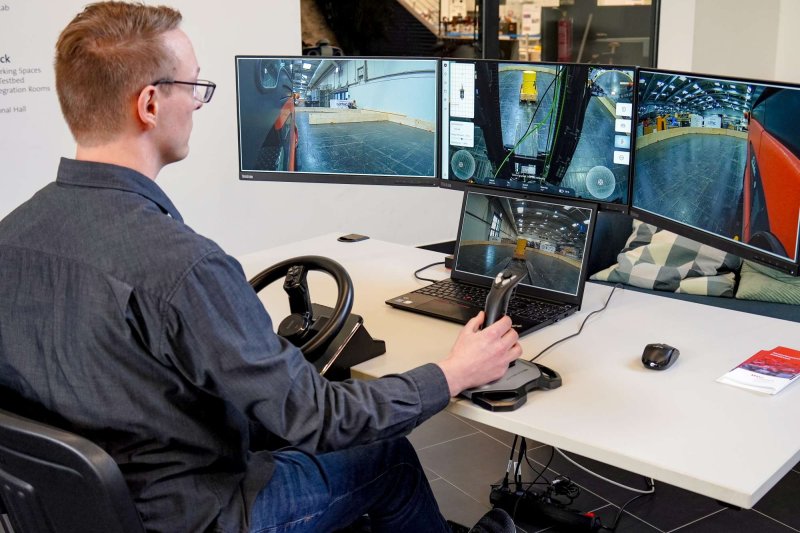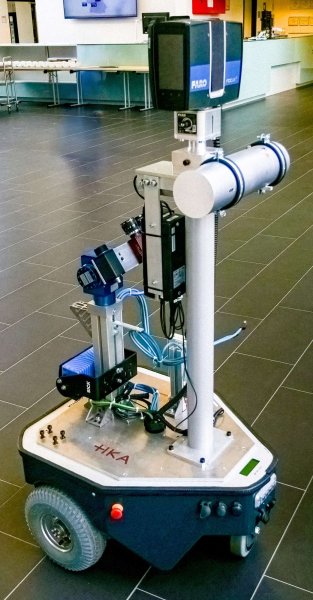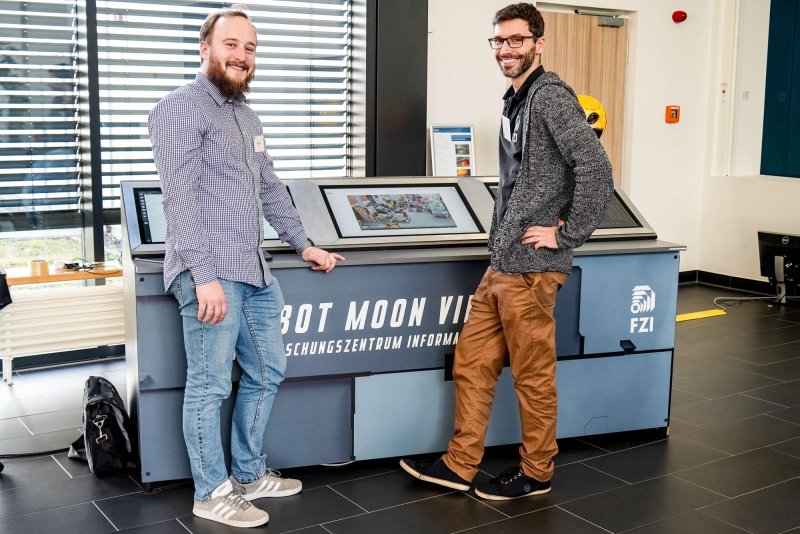· Press Release
Multi-robot decontamination: ROBDEKON is showcasing collaborative autonomous robot systems
Heavy construction machinery and robots that autonomously map the environment, pick up and transport objects: The ROBDEKON competence center presented its autonomous decontamination robotics technologies to an interested professional audience on October 23 and 24. Around 50 experts from the energy industry and companies working on the remediation of contaminated sites were able to experience the robots in live demonstrations, control them themselves and find out about the advanced state of development. This year, the industry meeting took place at the Robotics Innovation Center of the German Research Center for Artificial Intelligence (DFKI) in Bremen.
The focus was on autonomous systems working together as a team: different robots communicate with each other and solve complex decontamination tasks together. For example, the machines can explore an unknown environment, map and collect potentially contaminated objects, remove layers of soil or mill off contaminated surfaces. The ambitious vision of the ROBDEKON researchers is an end-to-end automated decontamination chain: humans should only give the basic order, while the machines then plan and carry out the necessary work steps independently. Even before this complete automation is implemented, ROBDEKON technologies make it possible to keep people out of danger and make their work much easier.
At the participation event in Bremen, the ROBDEKON partners presented the latest research in the field of decontamination robotics and discussed specific use cases and technological challenges with the audience. The live demonstrations were a highlight, allowing participants to interact with the systems themselves:
Teleoperation from a mobile operations control center
The situation at the site was displayed in the DFKI control center. This enabled human operators to teleoperate construction machinery over long distances and to monitor heterogeneous systems during the (partially) autonomous execution of tasks.
Situation visualization in VR
The Intelligent Sensor-Actuator Systems (ISAS) department at the Karlsruhe Institute of Technology (KIT) makes it possible to visualize the situation from the DFKI control center on various end devices. The iviz visualization software provides a highly immersive user experience.
Assistance for construction machines through mobile robot systems
The autonomous walking robots Spot from Fraunhofer IOSB and Fraunhofer IOSB-AST explored the site and the building using various LiDAR sensors. The ARTER excavator thus had access to a jointly created map from which information about the navigability and obstacles on the site can be derived.


AI-assisted grasping of barrels with an excavator
The autonomous excavator ALICE from ROBDEKON enables visitors to perform teleoperated barrel grasping. The excavator in Karlsruhe sends live camera images and recognized barrels online to Bremen. Visitors select a barrel, which the excavator grasps using 3D estimation.

Multi-Roboter-Kartierung für die Handhabung von Gefahrstoffen
The multi-robot team from the FZI Research Center for Information Technology, which can be intuitively controlled from Bremen, generates a picture of the situation in Karlsruhe and supports human operators in the recovery of hazardous materials.
DekontBot
The teleoperation of the DekontBot from the KIT Institute of Technology and Management in Construction (TMB) was also on display. In the future, it will be used to mill off contaminated areas during the dismantling of nuclear power plants or, in another setup, to measure the clearance of the treated areas.

Teleoperation of a forklift in Hannover
Operators in Bremen controlled the automated forklift in Hanover via video transmission from Götting KG's teleoperation control center in order to transport potentially hazardous goods safely and precisely.

Grasping of plant parts
The guests in Bremen supported the humanoid decontamination robot ARMAR-DE from the KIT Chair of High Performance Humanoid Technologies (H2T) in selecting suitable grasps for handling unknown plant components.
GammaBot
The GammaBot robot from Karlsruhe University of Applied Sciences can create precise 3D models of buildings using a laser scanner. It also determines the local dose rate for the dismantling of nuclear facilities.

Operations in a real environment
The competence center »Robotic systems for decontamination in hazardous environments« (ROBDEKON) has been funded by the Federal Ministry of Education and Research since 2018 and is currently applying the research results in initial pilot projects. Further test deployments are planned and cooperation partners are still being sought, as Dr. Janko Petereit, scientist at Fraunhofer IOSB and ROBDEKON coordinator, explained at the participation event: »The test runs in a quarry or in the vicinity of nuclear power plants have shown that our systems can complete the tasks assigned to them autonomously and successfully in real-life deployment scenarios. Through such practical tests, we gain new training data and experience that helps us to make our systems more robust. We look forward to hearing from other interested parties who would like to test this in their environment.«
ROBDEKON offers solutions for complex decontamination tasks
The operating companies are facing major challenges with the dismantling and decontamination of nuclear facilities, the remediation of contaminated sites and landfills or the recovery of hazardous materials. These issues can be solved by ROBDEKON. To this end, the partners from research and industry have developed various robotic systems that can perform specific tasks autonomously or teleoperated in order to relieve the burden on humans during hazardous operations. The (partially) autonomous technologies and the technical expertise of ROBDEKON also enable the decontamination of places that were previously inaccessible or difficult to reach.
The next ROBDEKON participation event is expected to take place in the fall of 2025.
Über ROBDEKON
ROBDEKON is one of two centers of excellence for robotic systems funded under the BMBF's "Research for Civil Security" program since 2018. It is coordinated by the Fraunhofer Institute of Optronics, System Technologies and Image Exploitation IOSB in Karlsruhe. Research partners are the Karlsruhe Institute of Technology (KIT), the Robotics Innovation Center of the German Research Center for Artificial Intelligence (DFKI), the FZI Research Center for Information Technology and Karlsruhe University of Applied Sciences (HKA). Industrial partners in the consortium are Götting KG, Kraftanlagen Heidelberg GmbH and ICP Ingenieurgesellschaft Prof. Czurda und Partner mbH. The current second funding phase will run until the end of 2026. The long-term goal is to establish a self-sustaining network of experts and users for new technologies for decontamination using robots. More at: https://robdekon.de







